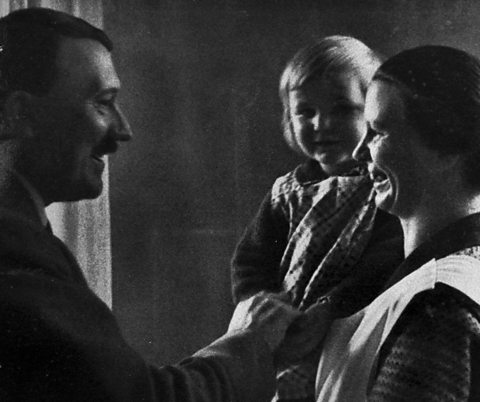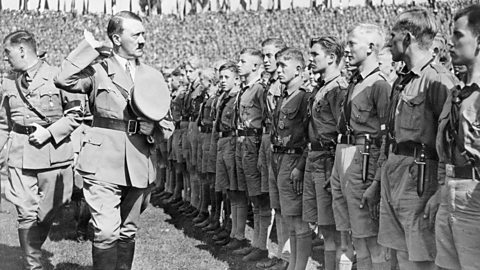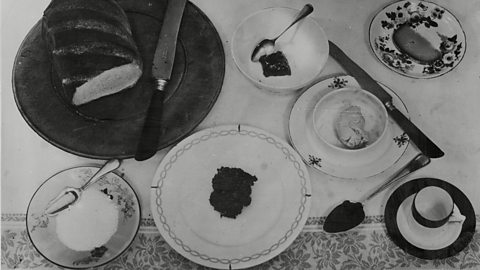Aryan ideals

Hitler promoted the importance of a stable, traditional family.
Men were to be in charge and protect their family.
Women were to serve and nurture their family.
Hitler wanted to use families to increase the size of the population and to ensure it was pure Aryan.
Thus, the Nazis wanted women to reproduce healthy Aryan children.

Question
What were Aryan ideals?
The Nazis believed that the German people were descended from a 'perfect' Aryan race.
'Aryan people' had blond hair, white skin and were regarded by the Nazis as a 'master race'.
The Nazis believed this race’s blood had been 'tainted' by the 'impure blood' of other races throughout the years.
Hitler and the Nazis wanted to return to an Aryan race and women played a crucial part in this.
Kinder, KĎ‹che, Kirche
In public, Hitler said women were “equal but different from men”, but he actually thought women were inferior.
Hitler believed women’s lives should revolve around the three 'Ks': Kinder, Küche, Kirche (Children, Kitchen, Church).
The Nazis expected women to stay at home, look after the family and produce children in order to secure the future of the Aryan race.
Marriage and children
Hitler wanted to increase the number of Aryan marriages and raise the birth rate.
He tried to accomplish this by:
- Introducing the Law for the Encouragement of Marriage in June 1933 which gave newlyweds a loan of 1,000 marks and allowed them to keep 250 marks for each child they had.
- Giving incentives to women who had a large number of children, such as the Motherhood Cross which awarded bronze for four children, silver for six and gold for eight or more.
- Making abortionThe medical process of ending a pregnancy so it doesn't result in the birth of a baby. illegal in 1933.
- Ensuring contraceptionAny form of birth control used to prevent pregnancy. was difficult to obtain.
- Taxing single men and childless families heavily.
- Making divorce easier through the Marriage Law of 1938.
Hitler tried to ensure only racially pure Aryan children were born by:
- Legalising sterilisationA permanent form of contraception which usually involves an operation to prevent a person from being able to reproduce. and abortions for those with 'disabilities' and those who were 'undesirables'.
- Encouraging unmarried women to have babies with Aryan SSThe Schutzstaffel, also known as the Blackshirts. A police/military style organisation created to serve as Hitler’s personal bodyguard. In Hitler's Germany they eventually controlled the intelligence, security and police forces, and the extermination of those they considered undesirable. men in a LebensbornA Nazi programme (meaning Fountain of Life) which aimed to create a strong Aryan 'master race'. It encouraged unmarried mothers and single women to birth children with SS members. The Nazis established several 'birthing homes' where this could take place secretly. home.
- From 1935, demanding proof of racial purity before a marriage could go ahead.
- Passing the Law for the Protection of German Blood and German Honour of 1935, which forbade marriages between AryanA person of European descent - not Jewish - often with blond hair and blue eyes. The Nazis viewed Aryans as the superior human race. and Jews, people belonging to ethnic minorities and RomaA group of people (Romani) that arrived in Europe in migrations from northern India around the 14th century..
Employment
Hitler said a woman’s role was to be a mother and not to work outside the home.
This was for two reasons:
- He wanted them to raise more AryanA person of European descent - not Jewish - often with blond hair and blue eyes. The Nazis viewed Aryans as the superior human race. children.
- He needed their jobs to give to unemployed men.
Women were discouraged from working by:
- The introduction of the Law for the Reduction of Unemployment (1933), which gave women financial incentives to stay at home.
- Barring women from being judges in 1936.
- Removing women from the civil service from 1933.
Women were not expected to work in Nazi Germany.
However, such was the skills shortage in Germany that, in 1937, a law was passed which meant women had to do a Duty Year.
This meant that they could undertake patriotic work in a factory to help the Nazis in their rearmament Manufacturing arms to support a growing military. drive.
Appearance
The appearance of and freedom of choice for women in Nazi Germany was also limited.
Women were not allowed to wear make-up and following fashion was discouraged, including wearing trousers.
Hair was not to be dyed and had to be worn in a certain style, usually a plait or a bun.
Diets were discouraged whilst abortions were very difficult to obtain.
The German Women’s Enterprise had six million members and trained women in household and parenting skills.
Impact of Nazi actions and policies
Employment
- Female employment initially dropped. Those in professions were worst affected. In 1933, 15 per cent of teachers lost their jobs and 19,000 female civil servants were sacked. Only 11 per cent of university places were given to women.
- Manual workers were affected less than those in professions, but some had to accept badly paid agricultural jobs.
- By 1939, there was a shortage of workers so more females were encouraged back into employment. This led to 50 per cent more women working in industry, but women in the professions were still rare.
Marriage and children
- The number of marriages increased by over 200,000.
- However, divorces also increased, especially after changes to the divorce laws in 1938.
- About 320,000 men and women were sterilised.
- Infant mortality dropped because of improved sanitation and preventative medicine.
Politics
- Females were excluded from decision-making, for example, they were not allowed to be members of the ReichstagThe German Parliament..
The effectiveness of Nazi policies by 1939
Successes
- Most women complied with Nazi policies.
- Many women, especially from the working class, actually approved of the three 'Ks': Kinder, KĂĽche, Kirche (Children, Kitchen, Church) and accepted a traditional role.
- Hitler gained supporters because of his policies on women and the family. Lots of women were pleased with the Nazis’ stricter rules in society - they had disapproved of the moral decline of the 1920s.
- Many women enjoyed the leisure activities, such as evening classes, outings to theatres and sports events, run by the Strength Through Joy (KdF)A Nazi organisation set up to organise leisure activities. movement.
Failures
- Although the birth rate increased, it was still lower in 1939 than in the early 1920s.
- Many women, especially manual workers, managed to keep their jobs due to a lack of replacements. The number of women in employment actually rose by 2.4 million between 1933 and 1939 because there was a shortage of workers for the rearmament factories and the autarkyA closed economy. Hitler's ideology that wanted Germany to cease trade with the outside world and rely entirely on its own resources. drive. In 1939, the Nazis had to reverse their employment policy and encourage women to return to the labour force.
- Hitler claimed to be a supporter of the traditional family, but some of his policies contradicted this, for example, making divorce easier and the setting up of LebensbornA Nazi programme (meaning Fountain of Life) which aimed to create a strong Aryan 'master race'. It encouraged unmarried mothers and single women to birth children with SS members. The Nazis established several 'birthing homes' where this could take place secretly..
- The annual number of marriages increased at first, but then the rate levelled off.
Test your knowledge
More on Life in Nazi Germany, 1933-45
Find out more by working through a topic
- count5 of 7

- count7 of 7
